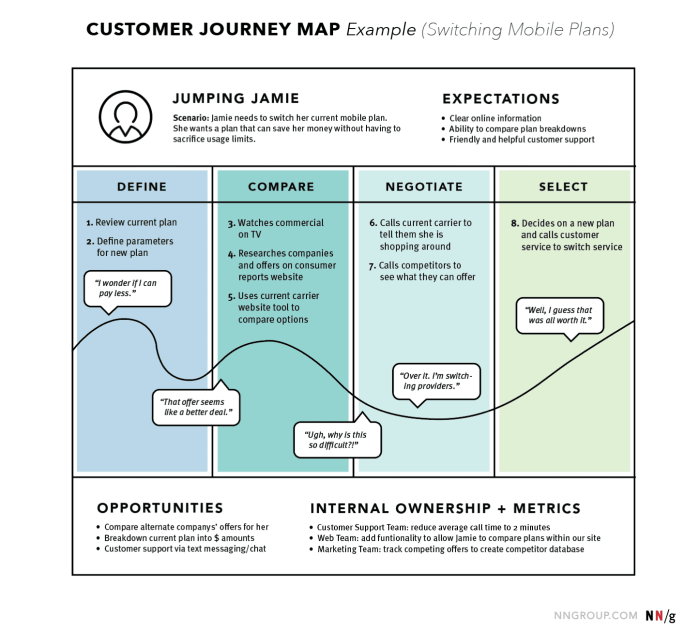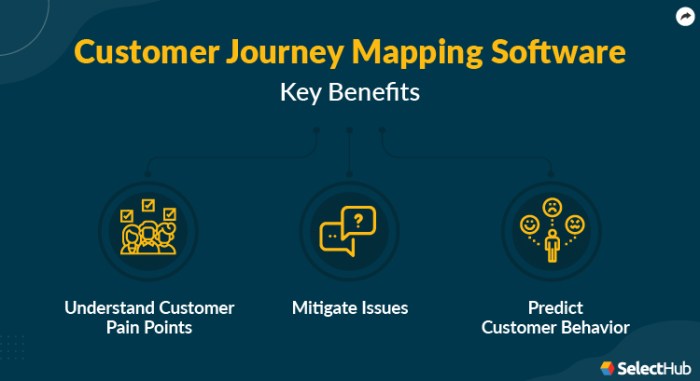Best CRM software for customer journey mapping offers businesses a powerful tool to understand and optimize the customer experience. This exploration delves into the key features, leading platforms, and implementation strategies for effectively mapping and improving the customer journey using CRM technology. We will examine how integrating data from various touchpoints allows for a holistic view of customer interactions, ultimately leading to increased customer satisfaction and loyalty.
Through detailed comparisons of popular CRM systems like Salesforce, HubSpot, and Zoho, we will highlight their strengths and weaknesses in supporting customer journey mapping. This analysis will equip readers with the knowledge to select the most suitable CRM platform based on their specific needs and budget. We’ll also cover best practices, address potential challenges, and emphasize the importance of data privacy and security throughout the process.
Understanding Customer Journey Mapping and its Importance in CRM
Customer journey mapping is a powerful tool for visualizing the customer experience across all touchpoints. By understanding how customers interact with your business, you can identify areas for improvement and optimize your processes for greater customer satisfaction and increased revenue. Integrating this with your CRM system significantly enhances its effectiveness, moving beyond simple contact management to a holistic view of the customer relationship.
Defining Customer Journey Mapping and its Importance in CRM
Customer journey mapping illustrates the steps a customer takes when interacting with a business, from initial awareness to post-purchase engagement. It’s crucial for understanding customer behavior, preferences, and pain points. Mapping reveals areas of friction or delight, allowing businesses to tailor their strategies for better customer experiences. This improved understanding directly impacts CRM effectiveness by providing context for customer interactions, enabling more personalized and effective communication.
Key Stages in a Typical Customer Journey
A typical customer journey often includes stages such as Awareness, Consideration, Decision, Action, and Retention. Each stage presents unique opportunities to engage and nurture the customer. For example, during the Awareness stage, marketing efforts might focus on brand building. During the Decision stage, personalized product recommendations become crucial. Finally, the Retention stage involves loyalty programs and ongoing support.
Examples of Customer Journey Mapping Improving CRM Effectiveness
Imagine a customer who initially contacted your company through a website inquiry. A CRM system enhanced with journey mapping would track this interaction, linking it to subsequent email communications, purchase history, and even social media engagement. This holistic view enables proactive customer service, targeted marketing campaigns, and a deeper understanding of customer needs, leading to increased customer lifetime value.
Comparison of Traditional CRM and Journey Mapping Enhanced CRM
| Feature | Traditional CRM | Journey Mapping Enhanced CRM | Benefits |
|---|---|---|---|
| Customer View | Transactional data (contacts, sales, support) | Holistic view across all touchpoints, including emotional and behavioral data | Deeper understanding of customer needs and preferences |
| Interaction Analysis | Limited insights into customer journey stages | Detailed analysis of each stage, identifying pain points and opportunities | Improved customer experience and increased conversion rates |
| Personalization | Basic segmentation based on demographics | Personalized communication and offers based on individual journey stages | Increased customer engagement and loyalty |
| Predictive Analytics | Limited predictive capabilities | Predictive modeling based on journey data to anticipate customer needs | Proactive customer service and targeted interventions |
CRM Software Features for Effective Customer Journey Mapping

Several CRM features directly support effective customer journey mapping. These features enable the collection, analysis, and visualization of customer data, providing a comprehensive understanding of the customer experience. Data visualization tools are particularly crucial for interpreting complex data sets and identifying key trends and patterns within the customer journey.
Essential CRM Features Supporting Customer Journey Mapping, Best CRM software for customer journey mapping
- Comprehensive Data Integration: Ability to consolidate data from various sources (website, social media, email, etc.).
- Visual Workflow Tools: Tools for creating visual representations of the customer journey.
- Advanced Analytics and Reporting: Capabilities for analyzing customer behavior and identifying trends.
- Customization and Personalization: Ability to tailor the CRM to specific business needs and customer segments.
The Role of Data Visualization Tools
Data visualization tools within a CRM system translate raw data into easily understandable charts and graphs. This allows for quick identification of bottlenecks, areas of high customer satisfaction, and potential opportunities for improvement. For example, a visual representation of the conversion funnel can clearly show drop-off points, highlighting areas needing attention.
Data Integration from Various Touchpoints
A robust CRM system integrates data from various sources such as website analytics, social media interactions, email marketing campaigns, and customer support tickets. This unified view provides a complete picture of the customer journey, eliminating data silos and offering a 360-degree customer profile.
Data Flow and Analysis Process Flowchart
A typical flowchart would show data flowing from various touchpoints into the CRM system. Data is then processed and analyzed using built-in tools or integrated analytics platforms. The resulting insights are used to optimize the customer journey and personalize customer interactions. The flowchart would visually represent this data flow and analysis, illustrating the system’s ability to transform raw data into actionable insights.
Comparing Leading CRM Platforms for Customer Journey Mapping
Several leading CRM platforms offer robust customer journey mapping capabilities. Salesforce, HubSpot, and Zoho are popular choices, each offering unique strengths and weaknesses. A comparative analysis helps businesses select the platform best suited to their specific needs and budget.
Comparison of Salesforce, HubSpot, and Zoho
| Feature | Salesforce | HubSpot | Zoho |
|---|---|---|---|
| Journey Mapping Features | Offers robust analytics and visualization tools, integrates with various marketing automation platforms. | Strong focus on inbound marketing, provides tools for creating and analyzing customer journeys. | Provides basic journey mapping capabilities, integrates with other Zoho applications. |
| Visualization | Provides customizable dashboards and reports to visualize the customer journey. | Offers visual representations of the customer journey, highlighting key touchpoints and interactions. | Offers simpler visualization tools compared to Salesforce and HubSpot. |
| Pricing | Varied pricing tiers, can be expensive for smaller businesses. | Offers a freemium model, with paid options for larger businesses. | More affordable than Salesforce, offers a range of pricing plans. |
| Scalability | Highly scalable, suitable for businesses of all sizes. | Scalable, but may require more customization for larger enterprises. | Scalable, but may require additional integrations for larger deployments. |
Strengths and Weaknesses of Each Platform
Salesforce excels in data analysis and integration but can be expensive. HubSpot is strong in inbound marketing and journey visualization but might lack some advanced features. Zoho offers a more affordable option but may have limited advanced analytics capabilities.
Implementing Customer Journey Mapping within Salesforce: Best CRM Software For Customer Journey Mapping
Implementing customer journey mapping within Salesforce involves a structured approach. This includes defining key performance indicators (KPIs), configuring the CRM to track relevant data, and regularly analyzing the results to refine strategies. Customer segmentation based on journey stage allows for targeted interventions and personalized communications.
Step-by-Step Implementation Process

- Define your customer journey stages and KPIs.
- Configure Salesforce to track relevant data points at each stage.
- Use Salesforce reports and dashboards to visualize the customer journey.
- Analyze the data to identify areas for improvement.
- Implement changes based on the analysis and track results.
Metrics to Track and Analyze
- Conversion rates at each stage of the journey.
- Customer satisfaction scores (CSAT).
- Customer churn rate.
- Average revenue per customer (ARPU).
Customer Segmentation Based on Journey Stage

Salesforce allows for advanced segmentation based on various criteria, including journey stage. This enables targeted marketing campaigns and personalized support, improving customer engagement and retention.
Sample Report Illustrating Key Findings
A recent customer journey mapping exercise using Salesforce revealed a significant drop-off rate between the Consideration and Decision stages. This suggests a need to improve the clarity of product information and enhance the customer support process during this critical phase. Implementing these changes resulted in a 15% increase in conversion rates within three months.
Best Practices and Considerations for Customer Journey Mapping with CRM
Effective use of CRM data for customer journey mapping requires careful planning and execution. Data privacy and security are paramount, requiring adherence to relevant regulations and best practices. The insights gained should be used to personalize customer interactions and improve overall customer satisfaction.
Best Practices for Optimizing the Customer Journey
- Regularly review and update your customer journey map.
- Use data-driven insights to personalize customer interactions.
- Focus on improving the customer experience at each stage of the journey.
- Continuously monitor key performance indicators (KPIs).
Challenges and Limitations
Data quality and completeness are crucial for accurate mapping. Inaccurate or incomplete data can lead to flawed insights and ineffective strategies. Furthermore, integrating data from multiple sources can be challenging, requiring careful planning and execution.
Data Privacy and Security
Protecting customer data is critical. Adherence to data privacy regulations (such as GDPR and CCPA) is essential. Implementing robust security measures, including data encryption and access controls, is vital to maintain customer trust and comply with legal requirements.
Personalizing Customer Interactions
Customer journey insights enable personalized communications, targeted offers, and proactive support. This results in increased customer engagement, improved satisfaction, and ultimately, stronger customer relationships.
Final Conclusion
Ultimately, leveraging the right CRM software for customer journey mapping is crucial for modern businesses striving for success. By understanding the customer’s journey, identifying pain points, and personalizing interactions, companies can foster stronger relationships, boost customer retention, and drive significant revenue growth. This guide provides a comprehensive framework for implementing and optimizing this powerful strategy, paving the way for a more customer-centric and profitable future.
FAQ Corner
What is the difference between a customer journey map and a customer persona?
A customer persona is a semi-fictional representation of your ideal customer, while a customer journey map visually charts the steps a customer takes when interacting with your business.
How often should customer journey maps be updated?
Customer journey maps should be reviewed and updated regularly, at least annually, or more frequently if significant changes occur in your business or customer behavior.
Can smaller businesses benefit from customer journey mapping?
Absolutely! Even smaller businesses can benefit greatly from understanding their customer journey, allowing for focused improvements and resource allocation.
What are some common metrics to track in customer journey mapping?
Common metrics include customer satisfaction (CSAT), Net Promoter Score (NPS), conversion rates, customer lifetime value (CLTV), and website engagement metrics.
